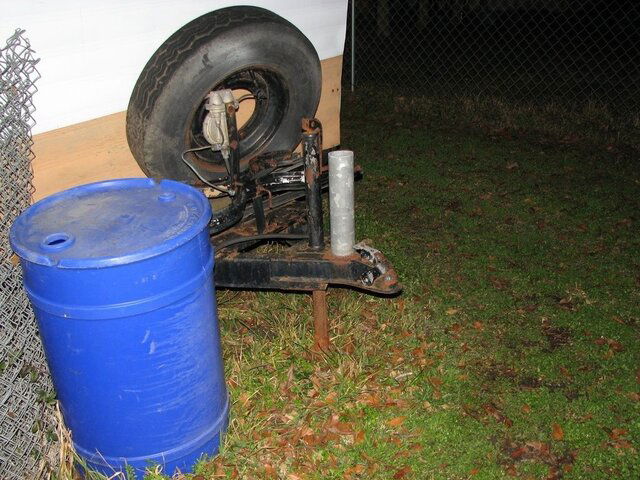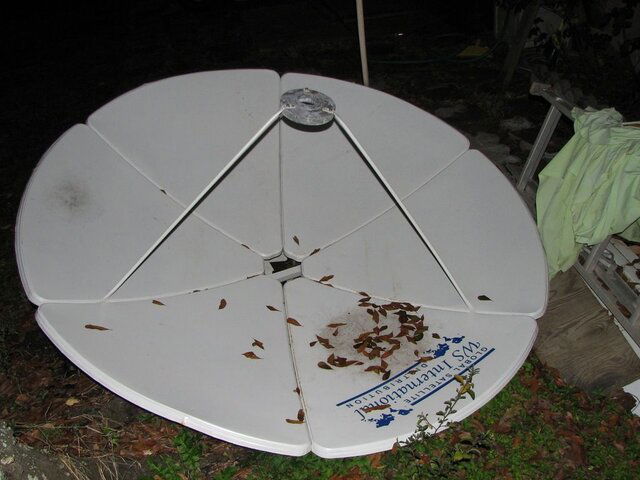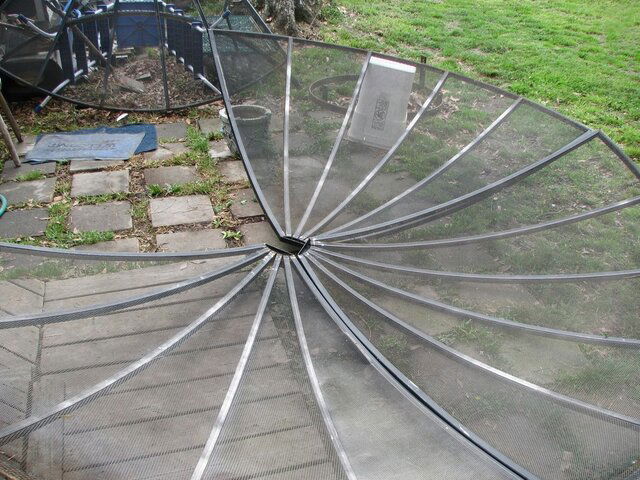Dee,
This is a really excellent thread for (not only your benefit in your personal project at hand here) but it is great information for "newbies" to the FTA hobby! They can read, first hand and step-by-step, how the process proceeds or doesn't proceed - due to weather and the elements or the availability of the "right" pieces that are required that you need to hunt and scrounge for. It is a perfect example for a DIY FTA project! It is also a great example of how we, as a group, come together for assistance of others.
This thread points out many of the hurdles that a person must contend with in order to play with this hobby. I was going to point out that us northerners were really eager to see you get your base foundation (the hole digging and post setting activities) accomplished because we cannot dig our own up here. The ground is covered in feet of snow and the ground is frozen. So we are kinda restricted by mother nature. However, I forgot that your backyard flooded and then turned to ice! Uuuugggghhh! You are not going to be out there chipping ice with a railroad pickaxe! I wouldn't either as that would be too extreme. It isn't worth that much effort. I've done a lot of crazy dish projects in the middle of winter, but I am NOT going to dig a hole through ice and snow and a few feet of frozen ground while it is snowing and blowing snow in 30 mph wind and colder than 15°F! I will wait til spring and 75°F and dry, sunny days.
This does bring me to state one thing. For me and many northerners, we use the time when mother nature doesn't work well for us (i.e. winter) to plan out our warm weather projects, to research data, ideas and scrounge for equipment. Anything that we can do inside - where it is warm. So don't feel discouraged because you cannot tackle specific elements of your project due to the weather issues, just take it as a blessing to be able to refine and double-check your plans and equipment lists. Maybe work on a few of the used components inside to clean them up and lubricate them - refurbish them so that they are truly ready to go! Take advantage of the time available for the appropriate part of the project.
One word of caution for you specifically, Dee. You mention a few times about turning down a pipe to fit the dish mount (to make the mast diameter acceptable to the mount of the dish itself). Be very aware of some pitfalls in doing this. First of all, many pipes are not that thick walled and turning them down on a lathe may really take away too much from the physical strength of the structure of the pipe, this is an obvious concern right off. It may become too thin to support the dish. You don't want to take away too much of that "meat". Secondly, many metal pipes are treated or coated (i.e galvanized piping) to prevent oxidation or rust. If you turn that pipe down, you remove that protective layer as it is very thin and only part of the very top exterior surface of the metal. This opens your metal mast up to the extremes of degradation in regards to rusting, which will weaken it moreso over time. There may be better methods to address this and I would take this time to research them. It is always best to use the right piece for the job and NOT modifiy it to make it fit by taking away from it.
Another item, about your backyard flooding often and standing with water. I assume that this is due to rain most often. I have riverfront property so when I think of my backyard flooding, I am envisioning much more than 2"-5" of standing water. I am thinking of 2 feet to 5 feet or possibly more of running water with tree limbs and other debris! Maybe even huge chunks of ice as big as a small bus! So, my impression (the visual picture in my mind) might be different from what your backyard truly looks like when you describe it as flooded. However, if you have consistent trouble with this issue, even if it is only a few inches in depth, you might consider doing something to help your yard drain better so that the water does not stand there for a long time. One idea that you can apply is this...
Locate the lowest point in your backyard, flag the very center of it when the standing water is nearly gone away. A few feet away from that point, at a location that is nearly the same level, but just a little higher, have someone auger a two foot diameter hole, down into the soil as far as they can. Then, backfill that hole with coarse rock and gravel. If you can get the hole deep enough to access more porous soil underneath the clay topsoil, the hole will provide a drain so that water will not stand so long in your yard. The rock and gravel will be a "strainer" like that in your bathtub to keep the drain open the longest over time. Sincerely, you can drain a lot of water this way. Research this if you plan to do anything like this so that you know how to lay the rock, gravel and sand in proper layers to keep the drain open over a long time. Sediment will eventually clog this drain, so you want to set it up the best way to keep it open the longest without too much maintenance.
Oh, you might question why I stated to auger the hole at a location higher than the lowest point. Most sediment and debris (grass clippings, tree leaves, etc) will collect at the lowest point moreso eventually and predominately thus, keeping the "drain area" from getting clogged. You can clean the "lowest" area with a rake after the water recedes completely. Less of that debris will float to your "drain" and collect there. This will extend the life of the drain.
OK, that last paragraph had very little to do with FTA satellite information, normally. But, you seem to have a unique problem with the drainage of your yard where you are desiring to install all your dishes. I recall one of your posts where your older dishes were standing on a smidgeon of land as an island in the middle of your back yard and you had to wade to get to them. You don't want that to be the future for all your backyard projects, FTA or other. So, this is my idea for you, if you think that the water drainage in your backyard is too much of a nuissance to put up with. This is a fairly cheap fix for this problem without having to install some sort of a pump to drain it. It is a passive and natural drainage system that works with as little effort or assistance from you. Just an idea that I wanted to relay to you. There are other methods to drain your water away that might be much more efficient and "long-lived", but they are also much more expensive. This simple "drain hole in the ground" is a really inexpensive and quick & dirty method to get the job done without tearing up and relandscaping your entire yard. And it can be accomplished in a few hours, if you have it already all planned out.
I hope that everything I have stated is helpful to you, Dee, and also to many others.
RADAR






